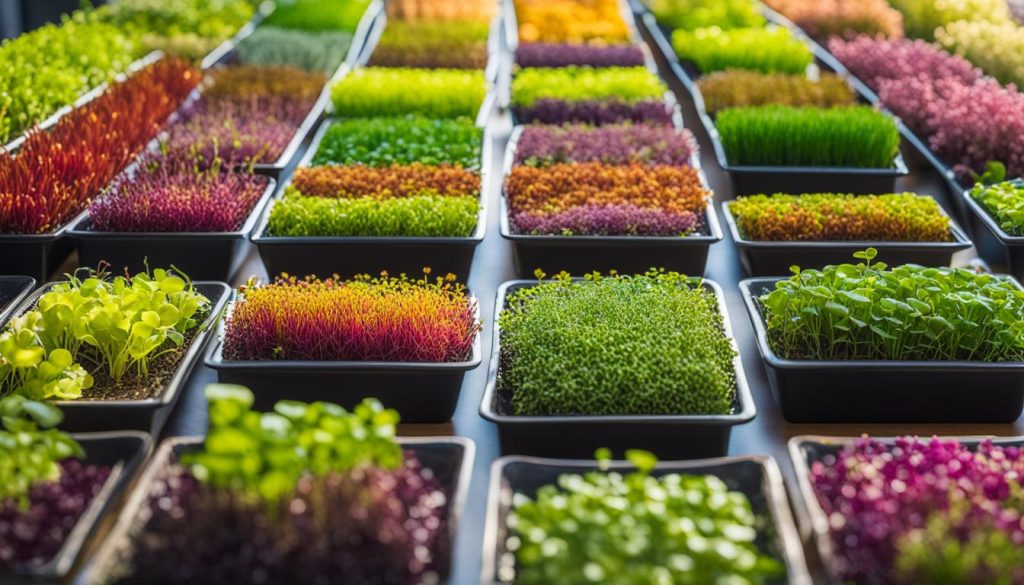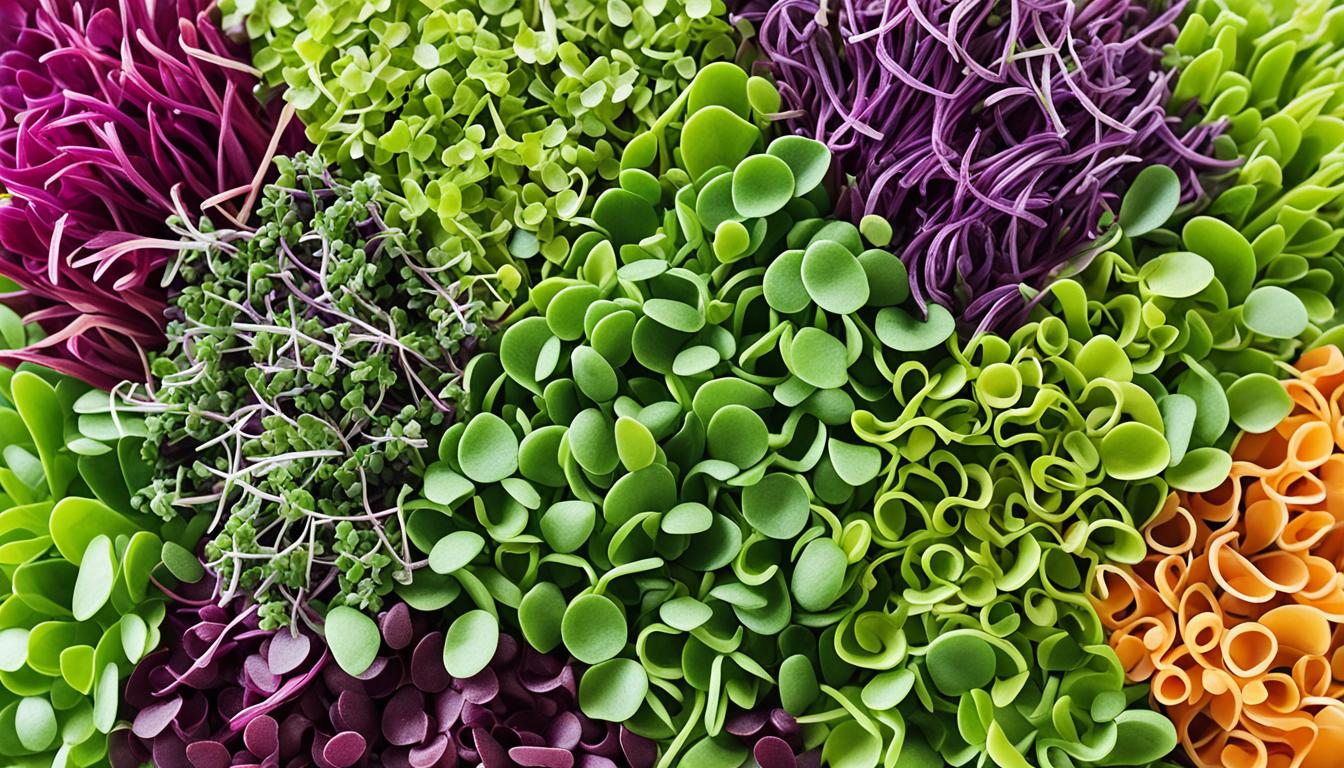Emerging from the vibrant Californian food scene of the 1980s, microgreens have ushered in a revolution in the realm of nutrition and gastronomy alike. Not just any ordinary garnish, these sprightly young greens offer a plethora of microgreens health benefits. Harvested soon after the first leaves emerge, their diminutive size belies the immense microgreens nutrition they pack. These tiny greens, ranging in height from 1-3 inches, offer a concentrated burst of flavor and nutrients that can make a significant impact on your daily diet.
Their stunning spectrum of colors and textures enhances the aesthetic appeal of any dish, while the essential microgreens vitamins and minerals they contain enrich the body’s health in measurable ways. As you enjoy the diversity of these tasty greens, remember that you’re indulging in more than just a culinary delight—you’re also partaking in a vital source of nutrition that is both delicious and easily incorporated into a healthy lifestyle.
Key Takeaways
- Microgreens are a flavorful, nutrient-dense source of essential vitamins and minerals.
- Despite their small size, they pack a more nutrient-rich punch than their mature counterparts.
- Adding microgreens to your meals can enhance both the visual appeal and nutritional value.
- They are versatile and can be grown in a variety of settings, making them accessible to many.
- Incorporating microgreens into your diet supports overall health with their high antioxidant content.
- The diversity of microgreen varieties ensures a wide spectrum of flavors and nutrients.
Understanding Microgreens: A Nutritional Overview
Microgreens have captured the attention of health enthusiasts and chefs alike, offering a unique balance of intense flavor and nutritional density. Their stature as nutrient-dense vegetables, sitting at an intriguing juncture in the plant life cycle, invites a closer examination of their growth and comparison to other stages of plant development.
Defining Microgreens and Their Unique Growth Stage
At the heart of the microgreens appeal is their microgreens growth stage. This developmental phase is specifically between the earlier sprout stage and the later baby green stage, typically spanning from 1 to 3 inches in height. Microgreens emerge after the first true leaves have unfolded, representing a growth spurt that is solely their own. This period is crucial for the accumulation of nutrients that occurs before the plant matures, thus maximizing their nutritional payload when harvested at this stage.
Comparison of Microgreens to Sprouts and Mature Greens
When it comes to microgreens vs sprouts, the differences are significant. Sprouts are germinated seeds that have not yet developed true leaves, usually consumed whole—seed, root, and shoot—within days of sprouting. Conversely, microgreens are given time to develop these true leaves and are cut just above the soil line, which some believe can help minimize the risk of microbial contamination. By contrast, mature greens are fully developed, with a much longer growth period that allows for the leaves to expand and the flavors to mellow. While still nutritious, mature vegetables often have less concentration of certain vitamins and minerals compared to their younger counterparts. This makes microgreens a preferable option for those looking to enhance their diet with nutrient-dense vegetables.
Wide Array of Microgreens Varieties
Microgreens, the tender, young shoots of various vegetables and herbs, represent a world of diverse flavors and culinary possibilities. Through expert microgreens cultivation, an expansive selection of microgreens seed varieties is turned into the vibrant, flavorful shoots that captivate the palates of food enthusiasts around the globe. These miniature greens not only elevate the aesthetics of a dish but also pack a punch with their concentration of nutrients and the unique taste of microgreens.
Exploring Different Seed Families Used in Microgreen Cultivation
From the peppery zing of radish microgreens to the subtle earthiness of beet leaves, the seed families used in cultivating microgreens are as varied as they are fascinating. The Brassicaceae family—home to favorites like kale, arugula, and cauliflower—stands out for its signature spicy kick. Alternatively, the Asteraceae family brings a variety of textures and mildly sweet notes with endive and lettuce seeds being popular choices for mild, yet crisp microgreens. Fans of delicate, anise-like flavors might look towards the Apiaceae family, which gives us carrot and cilantro greens that are beloved in both salads and garnishes.
Diversity in Flavors and Textures of Various Microgreens
The taste of microgreens can be as complex and diverse as the seeds they sprout from. A single bite might unveil nuanced undertones that vary from nutty to citrusy, with textures ranging from the tender crispness of amaranth to the succulent chew of sunflower greens. Experimenting with different types, such as grains transformed into wheatgrass or legumes sprouted into tender pea shoots, can introduce a bouquet of flavors and textures to the dinner table. This delightful spectrum of tastes ensures that microgreens remain not just a healthy choice but a culinary adventure.
Microgreens Health Benefits
Often heralded as a “superfood,” microgreens are increasingly recognized for their exceptional health benefits. Packed with essential nutrients, these miniature greens are synonymous with elevating wellness and offering disease risk reduction. Microgreens house a library of vitamins and minerals, as well as a powerful punch of polyphenols—antioxidants known for their capacity to combat various health issues.
Scientific studies have linked the routine ingestion of microgreens to a notable decrease in the occurrence of chronic diseases. The wealth of the nutrients found in these diminutive vegetables has shown to play a role in lowering triglyceride and LDL cholesterol levels, directly impacting heart health in a positive way. Furthermore, their influence extends to immune system support, arming the body’s natural defenses to operate optimally.
As we delve deeper into understanding how diet influences health, microgreens emerge as a natural ally in the fight against illness. By enhancing cellular sugar uptake, they are a beneficial component for those managing diabetes. The antioxidants they supply are believed to be instrumental in the management and potential prevention of conditions such as Alzheimer’s and certain forms of cancer. In essence, incorporating microgreens into one’s diet could be a small change that leads to substantial gains in overall health and longevity.
Microgreens Nutrition: A Closer Look at Vitamins and Minerals
The allure of microgreens extends beyond their vibrant colors and delicate textures; their nutritional profile is where they truly shine. These verdant gems pack a dense concentration of health-boosting nutrients into just a few bites, making them an essential component for a wholesome diet.
Concentration of Essential Nutrients in Microgreens
When examining microgreens, vitamins and minerals emerge as the stars of their nutritional ensemble. The tiny shoots are loaded with an abundance of potassium, iron, zinc, magnesium, and copper. This remarkable nutrient density means that even small servings of microgreens can provide a significant percentage of your daily nutrient requirements.
Comparative Analysis of Nutrient Content in Microgreens vs Mature Plants
A comparative nutrient analysis of microgreens versus their mature counterparts reveals some impressive findings. Certain microgreens boast vitamin and mineral levels that are substantially higher than those found in full-sized vegetables. Depending on the microgreen variety, some may contain up to nine times the nutrients found in mature plants, underscoring their potential as a nutritional powerhouse within our diets.
The Antioxidant Strength of Microgreens
Within the vibrant leaves of microgreens lies a powerhouse of nutritional value, specifically noted for their rich concentration of microgreens antioxidants. These tiny greens are not just a burst of color and flavor on our plates but a bastion of health, harnessing the potential to combat disease and enhance well-being.
The vigorous defense system provided by microgreens antioxidants plays a critical role in the body’s fight against damaging free radicals. This attribute is key in the path of disease prevention, as oxidative stress has been earmarked as a major accomplice in the development of chronic diseases, including heart disease and neurodegenerative disorders like Alzheimer’s.
Role of Antioxidants from Microgreens in Disease Prevention
Antioxidants from an array of microgreens such as red cabbage, cilantro, and radish serve in the front lines of disease prevention. These antioxidants counteract oxidative stress, which if unopposed, accelerates the aging process of cells and can evoke a range of diseases. In adopting a diet rich in microgreens, one fortifies the body’s defenses, empowering it to resist the onset of disease and nurture long-term health.
Diverse Range of Polyphenols Present in Microgreens
Beyond their antioxidant capacity, microgreens are especially notable for their polyphenols in microgreens. This diverse group of phytochemicals includes flavonoids, phenolic acids, and tannins, each contributing in its unique way to the antioxidant activity that these diminutive greens provide. Polyphenols exhibit anti-inflammatory and anticancer properties, amplifying the health-giving narrative of microgreens in our diets.

As voluble evidence mounts, it becomes clear that these miniature but mighty greens should figure prominently in our dietary routine―not just as a garnish or a splash of color, but as a substantial contributor to our body’s antioxidant defense system. By incorporating microgreens into our meals, we unlock an arsenal of benefits tailored for robust disease prevention and optimal health maintenance.
Microgreens and Heart Health
When it comes to supporting heart health, microgreens are not just a flavorful addition to your diet but also a strategic ally against cardiovascular diseases. These tiny yet powerful plants are dense with polyphenols, which play a pivotal role in combating conditions related to the heart. Studies have indicated that regular consumption of microgreens can lead to LDL cholesterol reduction, effectively lowering the levels of the so-called “bad” cholesterol that’s often linked with increased heart disease risk.
The appeal of microgreens extends beyond their nutritional value; it’s the accessibility of these nutrients that makes them a standout. Incorporating microgreens into your meals is a straightforward way to ingest polyphenols, known for their antioxidant properties. These compounds are essential in maintaining a healthy balance within your cardiovascular system, thanks to their ability to modulate blood lipid levels. Including microgreens in your diet can be a simple yet effective approach to foster heart health maintenance and prevention of heart-related issues.
Boosting Your Immune System with Microgreens
Incorporating microgreens into your diet is not just a trend; it’s a lifestyle change that can significantly enhance your body’s natural defenses. These tiny greens pack a considerable punch when it comes to immune-supporting nutrition, offering a cornucopia of vitamins, minerals, and antioxidants essential for maintaining a robust immune system.
Microgreens As a Source of Immune-Supporting Nutrition
The veritable arsenal of nutrients found in these nutrient-rich microgreens is impressive, ranging from high levels of vitamins A, C, and E to minerals like iron and phosphorus. Consuming a variety of microgreens can contribute to a strong foundation for immune health, giving your body the tools it needs to fend off pathogens and recover swiftly from illness.
Specific Nutrients in Microgreens That Enhance Immunity
Beyond the well-known vitamins and minerals, microgreens also contain a spectrum of phytonutrients and enzymes known to support the immune system. For instance, the high level of vitamin C in pea shoots helps with the production of white blood cells, vital in fighting infections. Similarly, the abundant vitamin E in certain microgreens like sunflower shoots acts as a powerful antioxidant, protecting cells from oxidative stress, which is crucial in immune response.
By integrating microgreens into your daily eating habits, you not only enjoy a boost of flavor but also contribute significantly to your overall wellbeing with immune-supporting nutrition that can help keep you healthy all year round.
The Role of Microgreens in Weight Loss and Digestion
In the journey towards improved health and wellness, finding foods that are not only nutritious but also aid in weight management and support digestive health is essential. Enter microgreens: the delicate yet mighty heroes of healthful eating. These tiny greens are not just a garnish but have proven to be pivotal in diets focused on weight loss and better digestive function.
Microgreens: A Perfect Addition to a Weight Loss Diet
For those seeking to shed pounds or maintain a healthy weight, introducing microgreens into meals can be a game-changer. Packed with nutrients while being low in calories, they provide an exceptional balance of vitamins and minerals without the added weight of excessive caloric intake. The versatility of microgreens also means they can easily make a dish more satiating, reducing the urge to reach for less healthy, calorie-dense options.
How Microgreens Fiber Aids in Digestion
The role of fiber in digestive health has long been lauded, and microgreens are a superb source of this essential dietary component. The microgreens fiber content not only encourages regularity in bowel movements but also supports a thriving gut microbiome, which is key for a balanced and smooth digestion process. Consuming microgreens as part of a wide-ranging diet enhances gut health, which, in turn, can affect overall well-being positively.
Whether you incorporate them into smoothies, salads, or as a vibrant topping for soups and sandwiches, microgreens can contribute substantially to one’s weight loss journey and digestive health.
Safe Consumption and Potential Risks of Microgreens
The allure of microgreens, with their vibrant colors and intense flavors, makes them an irresistible choice for enhancing the nutritional value of meals. Yet, as we integrate these tender plantings into our diets, it’s paramount to be aware of the safe consumption of microgreens and the practices that can avert the risk of foodborne illness. Unlike their sprout counterparts, microgreens grow in a soil medium or a soil substitute and reach a later developmental stage, which can generally reduce the foodborne illness risk. However, vigilance is key in maintaining their safety and ensuring that these nutrient powerhouses are enjoyed without concern.
Understanding the Risks of Foodborne Illness with Microgreens
Garden-fresh microgreens can be a wonder of nutrition, yet they are not immune to the threat posed by common pathogens such as Salmonella and E. coli. Although instances are uncommon, when microgreens are implicated in foodborne illness, it often traces back to contaminated seeds or unhygienic growing conditions. Hence, a foundational step in growing microgreens safely is committing to sources that prioritize seed quality and testing. Incidents of contamination are rare but can be significantly mitigated by adhering to rigorous standards of cleanliness and care during the cultivation process.
Best Practices for Growing and Consuming Microgreens Safely
To ensure the safe consumption of microgreens, it begins with how they are grown. Opting for reputable seed banks that test for microbial presence is a proactive step. During the growing process, emphasis should be on clean water sources, sterile equipment, and sanitized surfaces. After harvest, careful handling is just as critical. Wash hands thoroughly when touching microgreens, rinse the greens gently under cool, running water, and store them properly to maintain their integrity. Ultimately, the best practices encompass a holistic approach—considering every stage from seed selection to final consumption—to uphold the highest safety standards for these edible treasures.
Conclusion
As we’ve explored the various benefits and applications of microgreens, it’s evident that incorporating microgreens into your diet can play an integral role in achieving optimal health. By enriching your meals with these vibrant, nutrient-dense greens, you’re not just indulging in a culinary trend; you’re making a commitment to elevate your well-being. Microgreens are more than a refined garnish—they’re a practical way to intensify the nutritional value of every bite.
Incorporating Microgreens into Your Diet for Optimal Health
Embracing microgreens is straightforward and beneficial. These tiny greens are supercharged with vitamins and minerals, making them an excellent choice for enhancing your nutritional intake. Their ease of incorporation into daily meals ensures that you can consistently reap the rewards of their health-boosting properties. Whether you’re looking to support a robust immune system, maintain heart health, or just add more greens to your diet, microgreens are an exceptional choice.
Creative Culinary Ideas for Enjoying Microgreens
The versatility of microgreens extends far beyond traditional salads. Creative culinary uses of microgreens allow these edible miniatures to inspire your palate in new and exciting ways. Sprinkle them atop your pizzas for a lively flavor kick, blend them into your morning smoothies for a nutrient-packed start, or tuck them into sandwiches for added crunch and zest. The options are limitless, and as you experiment with different ways to enjoy microgreens, you’ll discover the joy of adding both color and nutrition to your plates. Achieving optimal health can be delightfully delicious with these tiny, yet mighty greens.


